The OnePlus 3 Review
by Brandon Chester on June 20, 2016 8:00 AM EST- Posted in
- Smartphones
- OnePlus
- OnePlus 3
System Performance
2015 was not a great year for Android devices. Snapdragon 810’s problems with throttling severely crippled the performance of high end smartphones. In the case of the OnePlus 2, OnePlus went even farther by putting in code that would detect when Google Chrome was in use and completely shut off the A57 cluster on the SoC. This resulted in web browsing performance that was essentially no better than what you’d find on a $100 phone shipping with Snapdragon 410, which simply wasn’t acceptable given the fact that the OnePlus 2 was priced at around $400.
Like most of this year’s flagship Android devices, the OnePlus 3 uses Qualcomm’s Snapdragon 820 SoC. We looked at Snapdragon 820 not long ago in the LG G5 review and saw that it provided a substantial improvement over Snapdragon 810, which became even greater when you consider prolonged workloads where Snapdragon 810’s A57 cores throttle down and shut off. Given that OnePlus no longer has any reason to put in strange app detection code to manage thermals, we should see a good uplift in general performance and an enormous improvement in web performance.
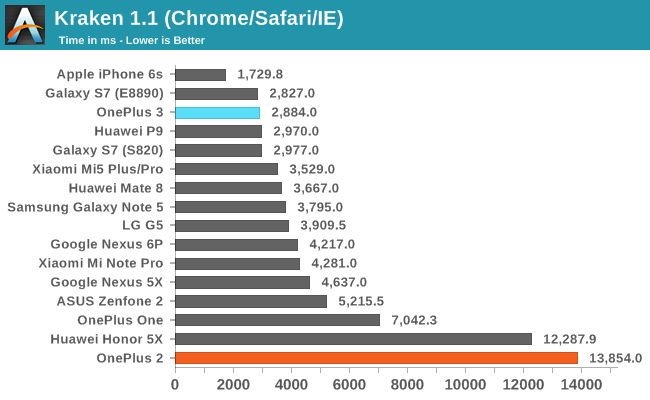
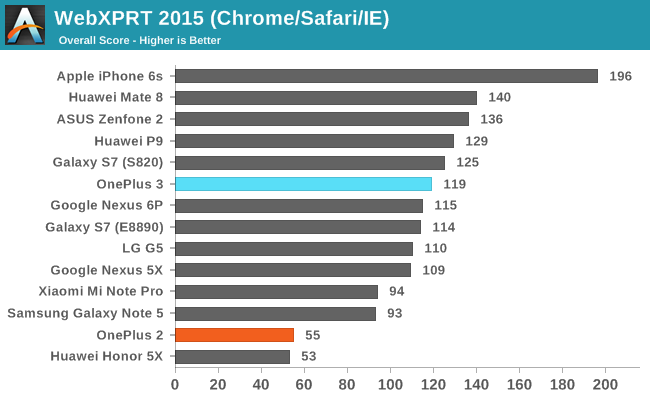
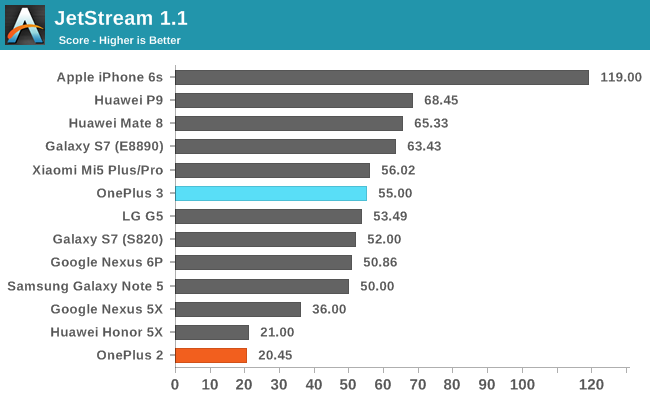
The improvement in web browsing performance when going from the OnePlus 2 to the OnePlus 3 is staggering. This isn't unexpected when you consider that the OnePlus 2 was just running on Cortex A53 cores that were meant for low power scenarios while the OnePlus 3 is using Qualcomm's Kryo cores. In Kraken the OnePlus 3 is over four times faster, while in WebXPRT and JetStream it's at least over two times faster. The OnePlus 2 actually represented a large regression in web performance compared to its predecessor, and OnePlus has brought web performance back to a level that is competitive with the other smartphones on the market with the OnePlus 3.

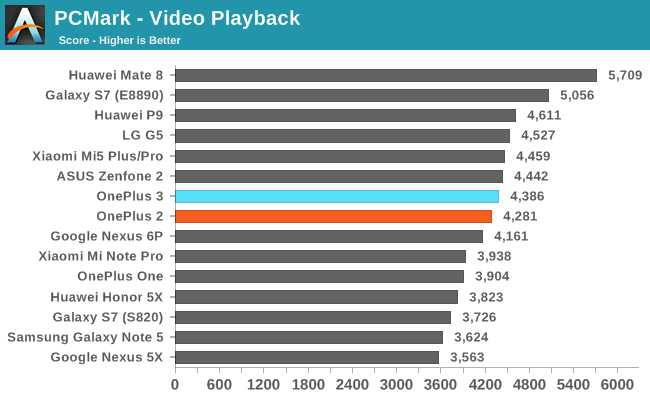

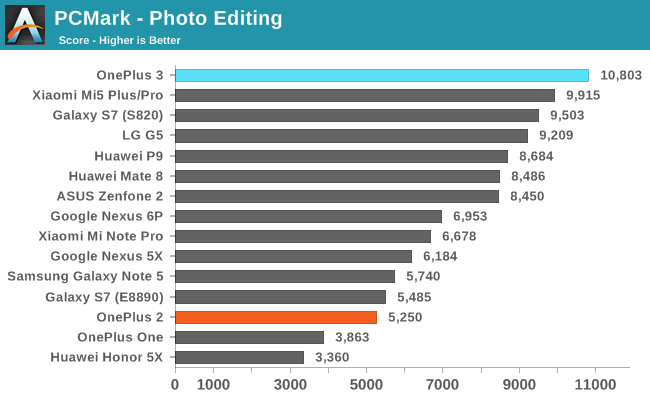
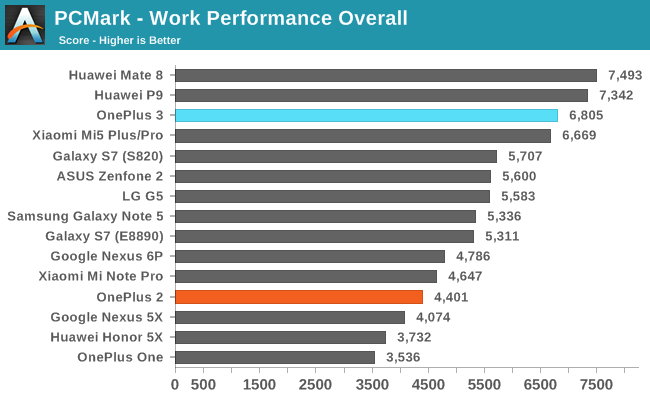
PCMark is an interesting test because it depends just as much on a phone's software as it does on the hardware. We've seen how devices with the same SoC can perform very differently, especially in certain sub-tests like the Writing and Photo Editing tests where different runtime and OS optimizations can have a large impact. The OnePlus 3 is no exception, with it achieving higher scores than the LG G5 in every test except for video playback where they have roughly the same scores.
This is not unexpected, as it was demonstrated in the LG G5 review that the G5 has more conservative frequency scaling than the other Snapdragon 820 devices that we've seen, which is reflected in PCMark's tests. In any case, the OnePlus 3 actually gets close to the Huawei Mate 8 in the writing test, and beats it and the LG G5 by a large margin in the photo editing test. In the end the OnePlus 3 places second on our overall chart, with only the Huawei Mate 8 ahead of it, and the gap between it and the Mate 8 being smaller than the gap between it and the Zenfone 2 which is the next fastest smartphone.
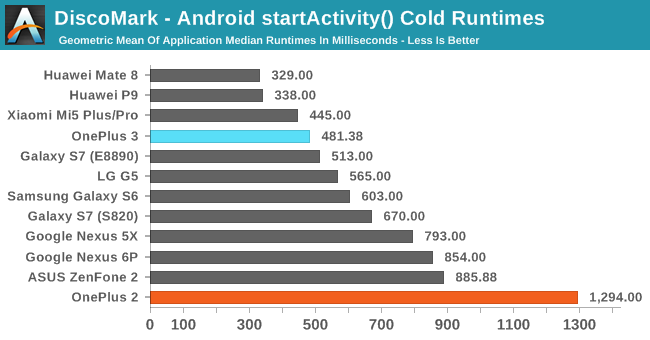
The OnePlus 3 is over two times faster than the OnePlus 2 with cold app launches where the application isn't resident in memory in any state. This is likely a combination of improved NAND performance, and changes to OnePlus's DVFS settings in addition to the performance improvements that Snapdragon 820 provides on its own. The impact that this has on the performance of the interface is significant, and when I reviewed the OnePlus 2 I noted how painfully slow it was to move around and through the applications. This new testing is a great example of that, with the OnePlus 2 taking 1.3 seconds just to launch apps, while the OnePlus 3 takes under 500ms and is the second fastest device here.
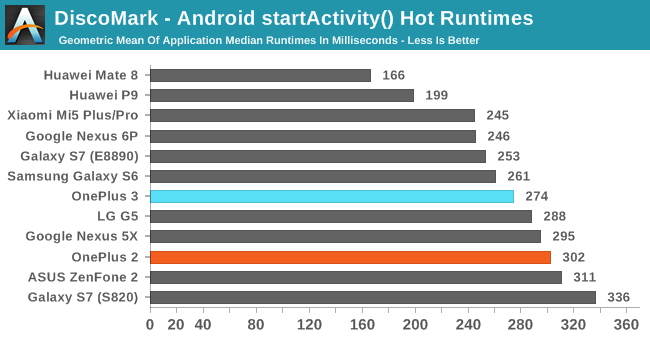
The OnePlus 3 improves a bit over the OnePlus 2 when resuming apps that are resident in memory, but not by a great deal. In general, all our devices hover between 250 and 300ms here, with the exception of the Huawei Mate 8 and P9 which are really in a category of their own for performance. While there's no enormous improvement here, the OnePlus 3 is competitive with other high end devices in the market, so there's nothing to complain about either.
One thing worth noting is that our set of apps wouldn't come close to utilizing the OnePlus 3's 6GB of RAM. Unfortunately, no matter how many apps we added, this would actually still be the case. The reason is that OnePlus has implemented very aggressive app eviction from memory, which means that your 6GB of RAM is really just sitting there using energy, and in general the utilization is pretty low. This may be a holdover from when the OnePlus 2 shipped in a 3GB configuration, but it's something OnePlus needs to address in a future OTA update. I'd imagine the Android enthusiast community is already at work on, or has already created custom kernels to alter this behavior as well. With 6GB of RAM you should be able to comfortably keep all of a user's frequently used apps resident in memory.
It's great to see that OnePlus is producing a smartphone with competitive performance once again. When the OnePlus One launched, Snapdragon 801 was the best you could get in an Android smartphone. The OnePlus 2 was an unfortunate victim of Snapdragon 810's heat and throttling problems, but OnePlus certainly didn't help the issue by hardcoding in mechanisms to detect Google Chrome and shut the A57 cluster off entirely. With the OnePlus 3 you get some of the best CPU performance in an Android phone, with PCMark's real-world tests demonstrating noticeable gains over the LG G5 which also uses Snapdragon 820. If I had to sum things up in a single line I'd just say that it's good to see that OnePlus is back in the game.


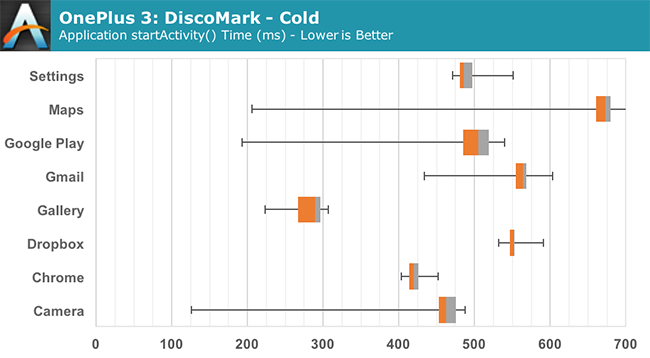
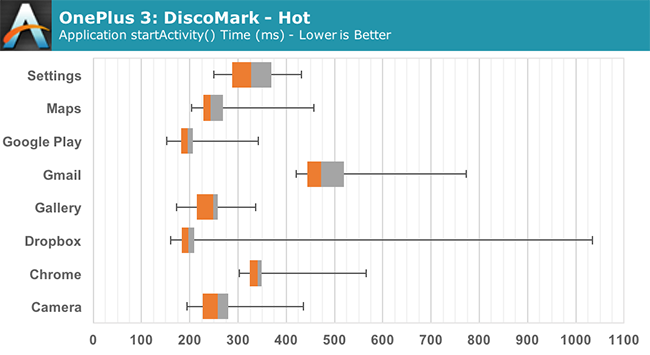








176 Comments
View All Comments
Buk Lau - Wednesday, June 22, 2016 - link
You are missing one important factor, Samsung gave out an sRGB option out of the box in their settings. They didn't tell you, and they don't necessarily have to tell you just like how they don't have to tell you that you can uninstall/disable 80% of the junk that came with TouchWiz. However, it is an option that came by default, while I agree it is bs for not actively notifying the user of it, you can still turn it on. More importantly, if you are reading AT's review, then you know what they are using right? So if you read their review and learned that they claim the display is good, you should have already known what settings they are using to get those metrics. So no, AT doesn't have to test the default option if AT tells you that they are using sRGB mode. You as the reader should have known after reading the review, just like when you look at any data you have to first understand how the test is setup. If they don't tell you that, then that's their problem. 1+ straight up had no other options, and the problem itself may not be even fixable with a software update, that's the differenceKepe - Monday, June 20, 2016 - link
The difference between other reviews and this one is that the others just look at some pictures on the screen and then write that the colors are very vivid and bright and they "pop". Anandtech measures the picture quality using proper tools instead of just looking at the screen with the naked eye and then saying something vague and subjective. And I'm glad they do, because I don't want a phone that skews colors on the screen. I do more image editing on my phone than on my computer. If the screen is inaccurate, the pictures will look very wrong to others when they look at them on their phones.zodiacfml - Tuesday, June 21, 2016 - link
Right. I have a Nexus 5 and the grays just pop out because of quality.Now though, I'm itching for Samsung's displays as it will give the best contrast and best late night viewing.
ssiu - Monday, June 20, 2016 - link
Nobody here interested in Daydream VR? I may not want to shell out hundreds for "is it just a gimmick" VR but I want my next phone upgrade to be Daydream VR compatible, I'll pay ~$100 incremental cost for a VR headset.I believe ZTE Axon 7 is a "flagship spec at midrange price" phone that is Daydream compatible and "coming soon".
tipoo - Monday, June 20, 2016 - link
I wonder if Daydream solves positional drift though. Since smartphones have no fixed reference points for VR, they were just approximating movement with the accelerometer and gyro, leading it to "drift" from your heads actual position. I hoped Daydream would solve that, but it seems the headset adds no extra sensors and is still a fancier "dumb" headset like Cardboard.dezonio2 - Monday, June 20, 2016 - link
I don't really care about Daydream, but ZTE Axon 7 seems to address all the shortcomings of the One+ 3.5.5" 1440p AMOLED (hopefully more accurate) and SD card slot seem like benefits worth paying the extra $50 for. And personally I'd rather see the review for the Axon 7 than the HTC 10 or the part 2 for the S7. Or even the GTX 1080. (runs away from the angry mob)
Eden-K121D - Monday, June 20, 2016 - link
Galaxy S7 review not out yet sometimes Anandtech is too lethargiccoder111 - Monday, June 20, 2016 - link
Just for a record- OnePlus has TERRIBLE CUSTOMER SUPPORT.DO NOT BUY if you want to receive decent warranty service.
I have a broken OnePlus2 which I have sent to service center twice. First time they sent it back without any repairs. Second time it took 10 days just to get the shipping label to send it to a different repair center. It has been there for 2 weeks now without any notice of what's going on or if I'll get my phone back in working order or when.
In between all this it takes a long time to get response from the customer support team. They often copy-paste canned responses without even reading what I have said in my ticket. There is now way to call someone and talk in person or at least have an on-line chat- everything is a ticket system where getting a response takes a day or several.
In short, my phone has been broken for 2 months, OnePlus is still to repair it or to send a replacement. I want my money back for experience like this.
fanofanand - Monday, June 20, 2016 - link
This post reflects reasons #1, 2 and 3 why I will not consider a OnePlus device. The cost savings aren't worth it when the customer service is similar to what you would experience with an eBay purchase. This isn't an isolated experience, forums are filled with angry customers who have non-functioning phones and OnePlus ignores the situation.zodiacfml - Monday, June 20, 2016 - link
Not interested. Waste of $400. I Can't wait for the Nexus.